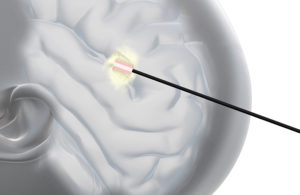Laser interstitial thermal therapy (LITT) has proven to be a successful and efficient treatment method for various brain diseases.
Anthony Cappabianca, Schott North America

It’s possible to use LITT during minimally invasive brain surgery to kill tumor cells or disrupt lesions responsible for epileptic seizures. [Image courtesy of Schott]
Thanks to advances in imaging, lasers and light delivery technology, it is now possible to use laser light to ablate lesions in the brain without the need for a craniotomy. This emerging neurosurgical procedure, known as laser interstitial thermal therapy (LITT) or laser-thermo ablation, can kill tumor cells or disrupt lesions responsible for epileptic seizures. Because the treatment is performed through a tiny opening in the skull about 4 mm in diameter (1/8 inch), recovery time for patients is greatly reduced.
Although just two LITT systems are approved for clinical use in the U.S. and one in Europe, additional systems are under development. There is a growing interest in this light-based therapy as more surgeons become aware of its benefits and better understand the best ways to apply it.
Light delivery is an essential component of LITT. The therapy uses high-power laser light delivered into the brain through a flexible fiberoptic catheter with a self-cooling probe. Light diffusers at the end of the probe homogeneously spread out the focused laser beam so that each cell receives the same amount of light. These diffusers might seem like a simple component, but they are critical for the precision surgeons need to avoid damaging healthy tissue during the procedure.
Treating the brain with light
Compared to traditional neurosurgery, LITT is quicker to perform and comes with a shorter hospital stay for patients. So far, it has been used to treat primary and secondary brain tumors, epilepsy, damage from radiation treatment and even chronic pain. LITT can be especially useful for brain lesions that are difficult to surgically access or for patients who can’t undergo surgical procedures or haven’t responded to standard treatments.
LITT’s therapeutic power comes from heating and ablating cells. This process requires high-power laser light delivered in a very targeted, predictable, and homogeneous way. Monitoring thermal changes in the lesion during the procedure is essential to ensuring that the ablation is complete, so LITT systems include an MRI machine that provides real-time temperature maps that neurosurgeons use to monitor tissue ablation during the procedure.
Diffusers are usually cylindrical in shape with a distal end that has been coated to eliminate forward light emission. They emit 360 °F light along a length of about 10 mm or less with a core fiber diameter that is usually 400 microns.
Selecting the best diffusers
When selecting diffusers to incorporate into LITT systems, there are several important considerations. For one, the diffusers must emit light power evenly distributed across the component’s entire length so that laser light is delivered homogeneously to the target area. This improves control of the delivered laser power and avoids hotspots, making it much easier to keep temperatures within a range that will produce predictable results.
Generating enough heat to ablate cells requires laser powers high enough to create photonic absorption and thermal conduction. Therefore, it’s critical to use diffusers that won’t melt or overheat when combined with higher wattage lasers.
This factor makes using glass-based diffusers an ideal solution for LITT. These diffusers incorporate unique scattering elements to achieve the required homogeneous light radiation. They can deliver laser light powers of 20 W or more with efficiencies typically between 80% and 90% for visible and near-IR laser radiation, including the 980 and 1064 nm wavelengths used in today’s commercial LITT systems. Such high efficiencies are possible because the diffusing material absorbs very little light, allowing delivery of more power to the target cells.
The circumferential distribution of energy for these diffusers is highly reproducible, very efficient and extremely homogeneous along the entire length of the device, allowing surgeons to heat tissue in a controlled fashion. Precise temperature control virtually reduces unwanted hot spots and prevents the tissue from overheating, which helps avoid damaging tissue near critical structures.
With a highly reproducible product quality, surgeons can expect the same performance and reliable treatment results every time a LITT procedure is performed.
New applications expand light delivery needs
As the number of available LITT procedures increases, surgeons have begun to express a desire for even more control over the area to which light is delivered. This can help them perform more delicate procedures while further reducing the risk of unwanted tissue damage.
It’s possible to produce glass-based diffusers in a variety of geometries. They serve as a very important component in state-of-the-art LITT systems, ready to meet surgeons’ growing needs for flexibility and versatility during their procedures. As innovation continues for the procedures themselves, it also must continue for the components necessary to make these advanced operations possible. Not only does this improve the efficiency of the procedure, it also further improves patient outcomes.
Anthony Cappabianca is principal business development manager medical at Schott North America. He has been with Schott for over 25 years. He is an expert in medical fiber optic illumination solutions in fields such as laser treatment, endoscopic and robotic surgery, dental applications and clinical diagnostics. Schott has been a significant designer and manufacturer of fiber optics and LED products for 60 years.
The opinions expressed in this blog post are the author’s only and do not necessarily reflect those of MedicalDesignandOutsourcing.com or its employees.